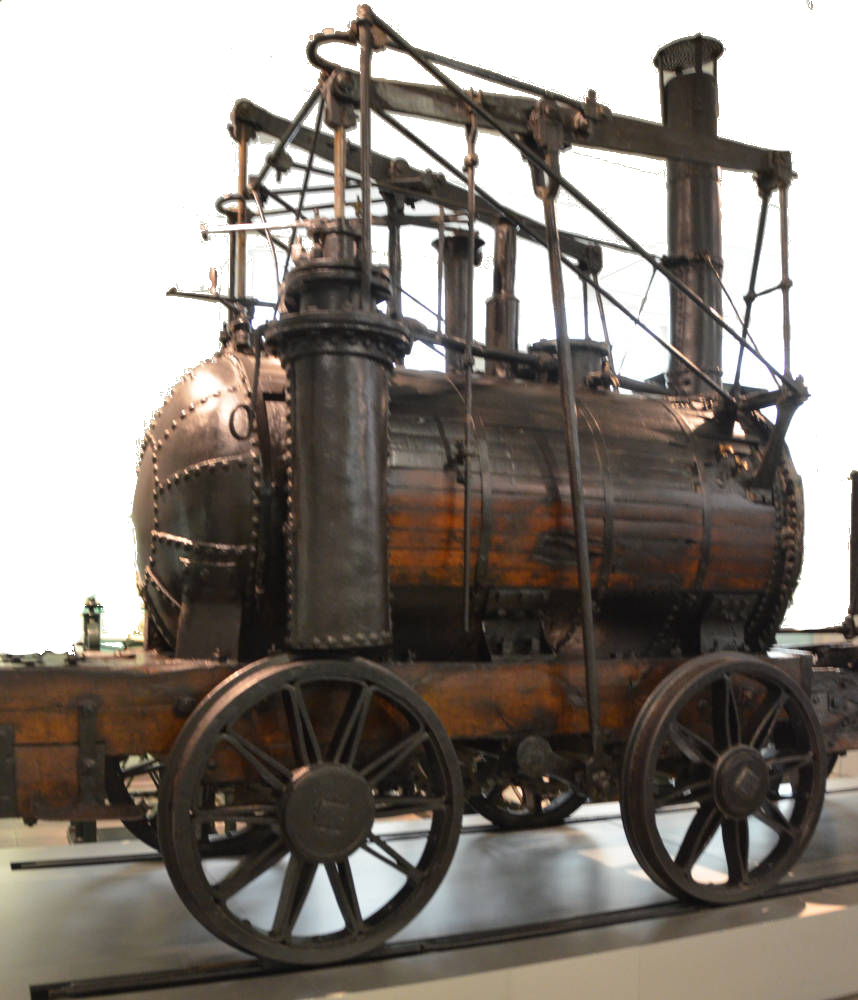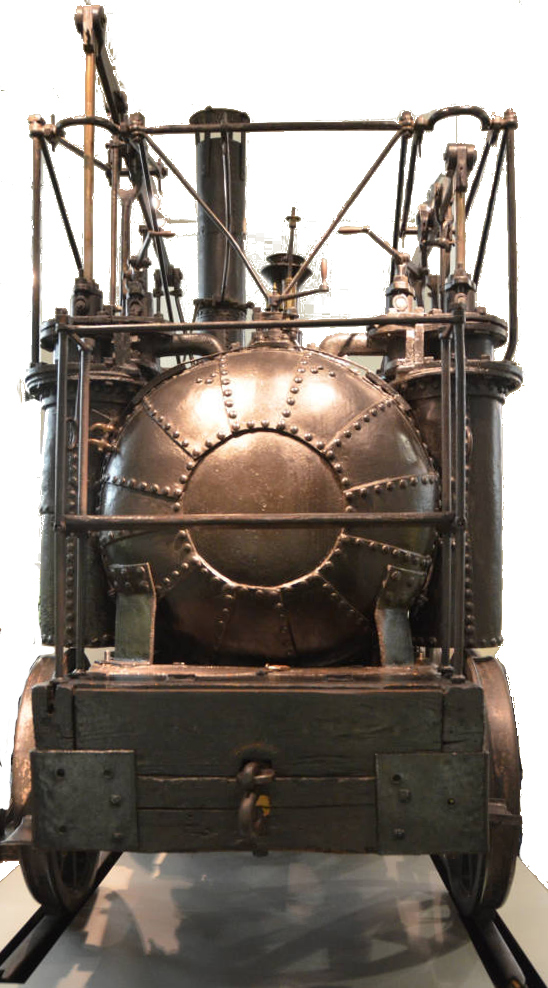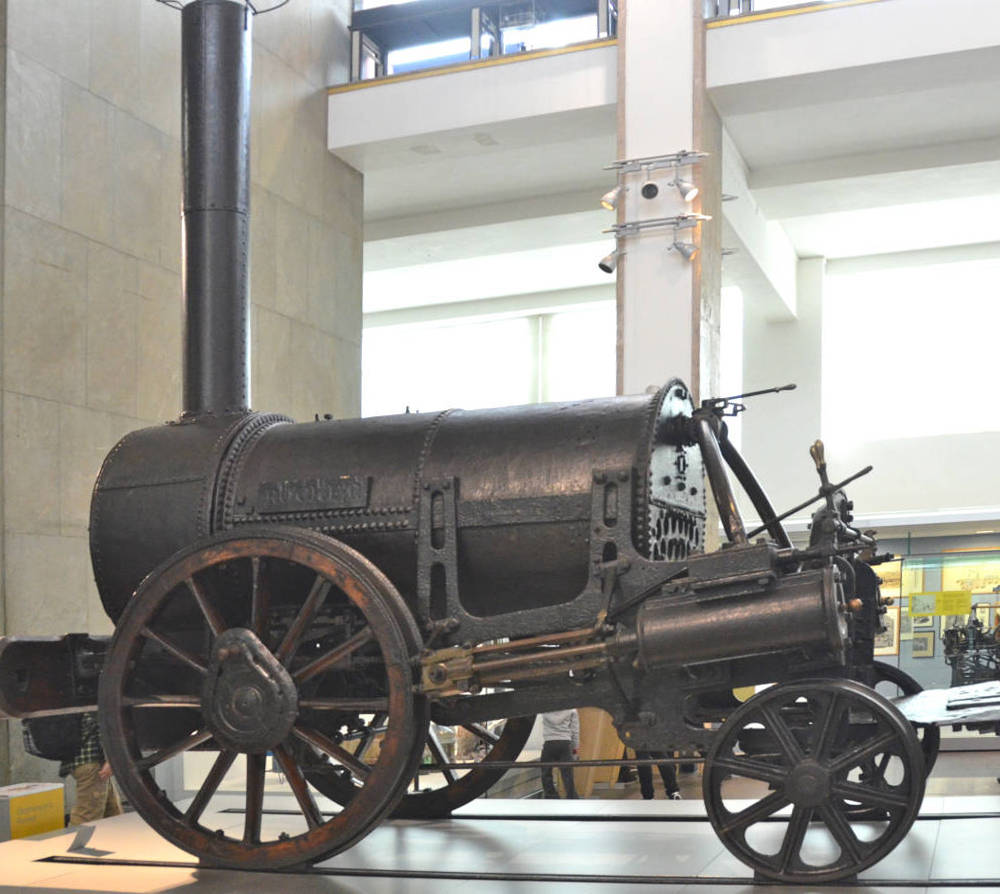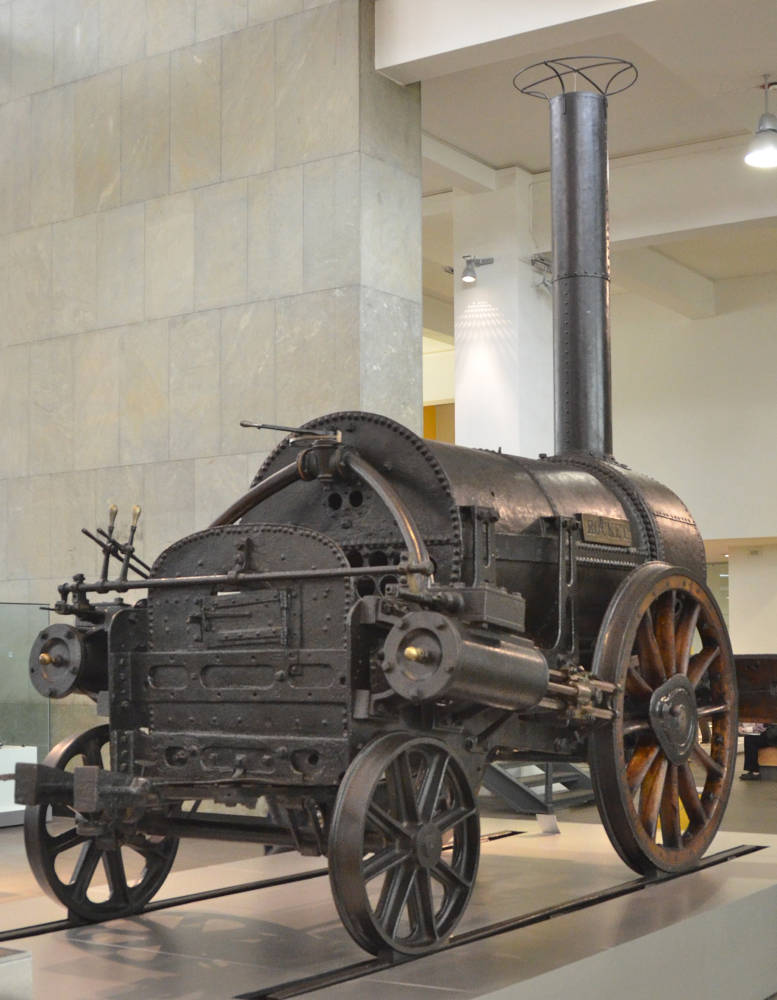The following article and its four wood-engravings comes from the Internet Archive version of the Illustrated London News (15 October 1864): 392-94. The text has been captured with ABBY FineReader 12.1.3 OCR software and edited, linked, and formatted by George P. Landow.

Since the invention of printing, no discovery has been made that has exercised so great a change and produced such remarkable and beneficial results to the whole human race as has the introduction of railways and that of steam carriages. By steam-locomotive power distance has been comparatively annihilated, and in conjunction with steam navigation, it has practically reduced the dimensions of the earth; for it has brought places previously far apart near to each other, as distance must be measured by time and not by mileage. The progress of mechanical science during the last half century has been most extraordinary — greater during that period than in the previous 500 years; for seventy years ago there neither existed steam engines that had rotatory motion, steam-ships, nor steam-boats; neither locomotive engines nor railways; neither spinning, weaving, nor manufacturing machines, except such simple ones as were worked by hand, beside the corn-mills, saw-mills, nnd a few others worked by water power, which occupied almost the exclusive attention of the engineers of that day, or, as they were then called, millwrights. Neither did the engineers of that time possess any of those beautiful mechanical contrivances called machine tools, with which they now produce with such facility the splendid specimens of mechanical contrivance constantly turned out by the makers of locomotives, marine engines, and machines for executing the most elaborate operations necessary for producing textile fabrics, and performing thousands of other important operations; bettering, cheapening, multiplying, and distributing to the millions of all nations those things which are necessary, useful, or ornamental. With the names of the great inventors of these things should always be associated those of such men as Bramah, Maudslay, Nasmyth, Whitworth, and others; for without the aid they have given to mechanics the inventions of such men as Watt, Arkwright, and Stephenson never could have been fully developed as they have been, or in so short a time.
To estimate this properly, we recommend our readers to visit the exceedingly interesting collection of mechanical objects in the Museum of Patents at South Kensington. There, grouped together, will be found some of the most interesting illustrations of the progress of mechanical science that may he seen anywhere. There is the steam-cylinder of the first passenger steam-boat that ever plied in England; and something older, the first engine ever put into a steam-boat, the first condensing steam-engine, the first screw-propeller, with many others. Surely these are rare antiquities, precious relics of great discoveries! That group of old blackened beams of wood, rusty cylinders of iron, and cogged wheels, on the east side of the building, is the identical old engine to which Watt first applied the results of his “happy thought,” the separate condenser. On the south side of the Museum are a couple of locomotive engines- old, very old — worn, bent, bruised, and rusty, but full of interest; for one is the oldest locomotive engine in existence, the parent of all that have since been produced — the original old “Puffing Billy” of the Wylam Colliery, constructed there, in 1813, by William Hedley, for Christopher Blackett, whose name will ever be remembered as one of the earliest and stanchest friends of the locomotive.



Puffing Billy. National Science Museum, London. Photographs by George P. Landow 2003, 2014. [Click on images to enlarge them.]
This “Puffing Billy” was not the first engine of Mr. Blackett. He had tried Trevethick's and other inventions, and had been nearly blown up several times, but at last this homely-looking, sturdy machine was perfected, and from that date (1813) up to a comparativelv recent period it has been dragging (very slowly, it is true) heatvy loads of coals and waggons to and fro. It has a battered, and bruised, and hard-worn look, with indubitable marks of extreme old age about it; but it was a good, hard-working, willing drudge, and has well earned the quiet time it will have in future, here in the Kensington Museum. Upon one side of it hangs a document, dated 1815, from which it appears some great objection had been made by local landowners to the putting propensities of the aforesaid “Billy,” and a case is referred for opinion to a barrister named Williams, whose opinion is that there is no objection arising from the lease itself to Mr. Blackett conveying his coal waggons by means of this steam-engine; but he thinks that the use of such an engine may be deemed a nuisance, if the smoke or noise of the engine disturbs the cattle grazing on the lands adjacent to the waggon-way. The locomotive have a narrow escape of being put down as a common nuisance. We might now as easily think of putting down earthquakes or eruptions of volcanoes as putting down the locomotive engine, but in those days it was different, and had an extinguisher been put on “Puffing Billy” at that time, the introduction of locomotives and railways for passenger trattic might have been delayed many years.



The Rocket. National Science Museum, London. Photographs by George P. Landow 2014. [Click on images to enlarge them.]
Beside this venerable specimen of mechanical ingenuity stands another locomotive engine, worn, bruised, strained, and cracked like its neighbour, but not so old as Puffing Billy, which dates as far back as 1813, while this did not come into existence until the year 1820. These engines are well placed side by side, for the spectator may, by looking at them in such a position, easily come to several important conclusions. In designing the old engine it is evident that its inventor never dreamed of any speed worth thinking of. To crawl along with a heavy load behind it was all that this engine was expected to do, and it did this patiently, but with a great deal of fuss and clatter, for half a century; and for such a performance, and considering its extreme old age, it is entitled to our highest respect. But, turning to its neighbour, we see that its inventor and constructor did think of high speed; there is a wonderful look of speed about it, and it did actually travel at forty miles per hour, for it is the celebrated “Rocket” engine of George Stephenson, the parent engine of our present locomotive system. This is really a very interesting relic, for it was the great starting-point of high speed and passenger railways. It is extraordinary how thoroughly George Stephenson grasped the entire machine. It is not only in this case that an important principle was introduced; the entire engine has a character throughout that shows that the mind of the great inventor comprehended the entire subject; and although since the time this machine was tested on the Manchester nnd Liverpool Railway, in 1830, so many of the most skilful mechanics in the world have been constructing engines by thousands for similar purposes, yet at the present moment all these engines now in use, in all parts of tho world, in their general characteristics, hear the stamp of the mind of George Stephenson upon them.
Our first Illustration is a view of the house in which George Stephenson was born. It is a small red-tiled cottage—one of such as are inhabited by working men in the colliery districts. It is two-storied, and contains four rooms. In one of the lower apartments, the walls unplastered, with the bare joists overhead, and the floor of clay, the father of the locomotive system was born. This house is situated ut the eastern extremity of the village of Wylam, a small, poor village on the north bank of the Tyne, surrounded with blast-furnaces, collieries, cinder-banks. and coal-hcaps. It was here that George Stephenson passed his childhood, played about beside the waggon-road, went bird-nesting, and ran errands to the village ; but he did not go to school; his parents were too poor, and bread too dear, to pay even the small amount necessary to send him to school, and so the first eight years of his life were passed. Thirty-five years after, in conjunction with Mr. Edward Pease, he founded the present locomotive manufactory at Newcastle, of the interior of which we this week give some Illustrations Mr. Smiles has most happily given to the world an account of how those thirty-five years of George Stephenson's life were parsed. He has traced with a loving hand the career of his hero, from the days when, as a boy, he herded cows on the Wylam waggon-way; when, a youth, he tried hard to recover the lost time of his childhood. by learning his letters and making pothooks and hangers; showing how, afterwards, he became a skilful hreaksman, and then an enginewright; and, for amusement, a shoemaker and clockmaker; eventually an improver of pumping-engines, the inventor of the miner's safety-lamp, a constructor of locomotives, and a designer and builder of hundreds of miles of railways.
The celebrated locomotive-works at Newcastle, now carried on by George Robert Stephenson, his nephew, include the premises in Forth-street, first occupied by George Stephenson. They were originally very small, and all the work had to be done by sheer skill and hard labour, for tools were few and simple in those days. Gradually these works have so increased in size and ability to execute orders, that they can now turn out a splendid new locomotive engine and tender of the largest size every week. They, therefore, deservedly rank amongst the largest engineering establishments in England, and they have been, moreover, a school for mechanics, who have disseminated in all parte of the world the knowledge here obtained.
The present works are of an extensive character, covering a great extent of ground, and contain large numbers of all the machine tools now in use for forging, shaping, and completing all the parts of locomotive engibes. First is the foundry, where large masses of metal are moulded intoshape by casting; but the forge in a locomotive manufactory is a far more important workshop than a foundry, and here forging is canned on with all the care, skill, and caution that human minds and hands are capable of applyiug to it; for upon the completeness, truth, and perfection of material and workmanship of certain parts of the locomotive, the safety of the passengers depends. The engine wheels, as might be expected, are objects of especial care, each being built up in separate pieces, and every part carefully welded to the other until a perfect wheel is produced, the quality of every portion of it being thoroughly known, and consequently it can be depended upon for bearing the sudden vibrations, strains, and jars it must become subject to in running at the terrific velocities now attained by some of our express-trains.

The Steam-Hammer.
Our first Illustration of the manufactory is a night view of that portion of the forging department containing the Nasmyth steam-hammers, which are used to hammer into shape the largest portions of the engine, such as the crank-axles. The forging of large masses of iron was a great difficulty with the older mechanics, and numberless contrivances were adopted to avoid the necessity of using them. Now the most colossal masses of metal are brought to the desired shape with as much ease as fifty years ago a smith would have made a forging of a few pounds weight.
The construction of the locomotive boilers, as may be expected, is a large and important division of the manufactory. Here the eternal din of closing rivets up is constantly maintained. Material and workmanship are here even more important than in the manufactories for the wheels. The boilers are constructed of plates of the finest iron, carefully riveted together, and afterwards subjected to the most severe tests. For the quality of this portion of the engine the Stephenson manufactory has always borne the highest character—the principle upon wliicli it is constructed as well as its form having been given to it by the celebrated founder of the establishment.

The Lathe and Tool Shop.
Our second Illustration represents, as well as a wood-engraving can render such a subject, a portion of the lathe and tool shop. There are machines and tools of every kind for turning, boring, cutting, slotting, drilling, planing, and shaping pieces of metal into every conceivable form. Their variety is astonishing, and they are packed so closely together that a stranger is unable to distinguish the crowd of mechanical contrivances, although he may look upon one of these workshops as a person ignorant of geography may look upon a map of a continent, and see nothing but a mass of confused lines. Yet there is no real confusion, Every separate part is busily engaged in producing a separate portion of an engine, without which the grand result, a noble locomotive, would not be perfect.

The Fitting Shop. Click on image to enlarge it.
Our third Illustration is a view of the large building called “the fitting shop.” It is here that, after all the separate portions of the locomotive have been constructed and finished, each in its separate department, all are brought together and placed in their proper relative positions by a highly skilled class of workmen called fitters, tinder the hands of these men the locomotive grows rapidly ; the frame is put together ; the work of the boiler-maker finds its place ; crank-axle and cylinder occupy their proper position; piston-rods, connecting-rods, eccentrics, and reversing-gear follow, with all the smaller portions, until a complete and perfect engine is produced.
Last modified 21 November 2015